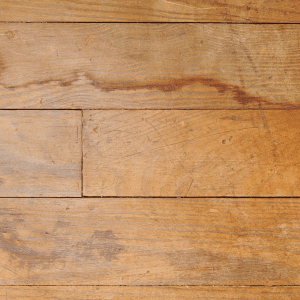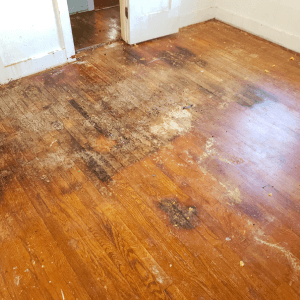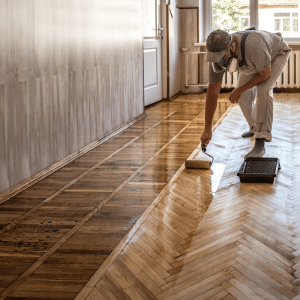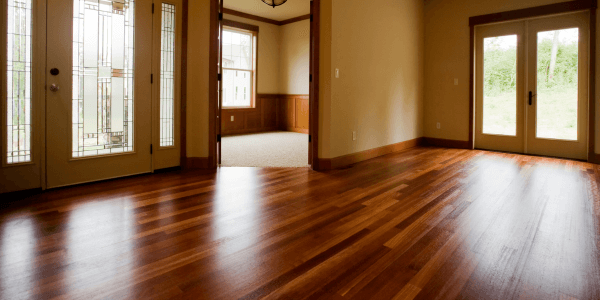When water meets hardwood flooring, the results can be devastating. Whether you’ve experienced a minor spill or a major water disaster, water-damaged wood floors are a serious issue that requires immediate attention. Black Hill Restoration in Austin, Texas, is here to guide you through this challenging situation and help you restore your beloved floors to their former glory.
All About Water-Damaged Wood Floors
What Causes Water Damage?
Water damage can stem from various sources, and understanding these can help you prevent future incidents. Common causes include:
- Natural Disasters: Floods, hurricanes, and heavy rainfall are notorious for causing significant water damage.
- Water Leak: Burst pipes, overflowing appliances like dishwashers or washing machines, and faulty plumbing can all lead to water-damaged hardwood.
- Environmental Factors: High humidity levels and consistent heavy rainfall can gradually deteriorate wood floors.
For a more comprehensive guide on water damage and hardwood flooring, visit the National Wood Flooring Association’s resource on Water Damage and Wood Flooring.
Types of Water Damage to Wood Flooring
Recognizing the different types of water damage is crucial for effective damage restoration:
- Surface Water Damage: This occurs when floor water sits on the surface of the wood, leading to staining and slight warping.
- Subsurface Water Damage: More severe, this type involves water seeping beneath the floorboards, causing extensive damage to the entire floor.
- Mold and Mildew Growth: Persistent moisture can lead to mold and mildew, posing health risks and further damaging the wood.

Identifying Water Damage on Wood Floors
Early identification of water damage can save you from costly repairs down the line. Here’s what to look for:
Early Signs of Water Damage
- Discoloration and Staining: Dark spots or uneven coloring on your wooden floor can indicate water exposure.
- Warping and Buckling: If the floorboards start to warp or buckle, it’s a clear sign of water damage.
- Musty Odors: A musty smell often suggests mold and mildew growth, which thrives in damp environments.
Advanced Signs of Water Damage
- Cupping and Crowning: When the edges of the floorboards lift or the centers bulge, your wood flooring is suffering from advanced water damage.
- Severe Warping and Lifting: Extensive water exposure can cause significant warping, making the floor uneven and potentially hazardous.
- Visible Mold Growth: Mold patches on the surface or between floorboards require urgent attention.
Immediate Steps to Take When Water Damage Occurs
Stop the Water Source
The first step in mitigating water damage is to stop the source of water:
- Shut Off the Water Supply: Immediately turn off the water supply to prevent further flooding.
- Address the Cause: Fix any leaks or repair faulty appliances to stop the water at its source.
Remove Standing Water
Removing standing water quickly is essential to prevent further damage:
- Use a Shop Vacuum: A wet/dry shop vac or water vacuuum can efficiently remove excess water from the surface.
- Mop and Towel Dry: Use mops and towels to absorb residual water and dry the area as much as possible.
Dry the Affected Area
Drying out the affected area is crucial to prevent mold growth and further damage:
- Use Fans and Dehumidifiers: These devices help to circulate air and reduce excess moisture levels.
- Ensure Proper Ventilation: Open windows and doors to promote air circulation.
How Black Hill Restoration Repairs Your Water-Damaged Wood Floors
- Assesment and Inspection

Our process begins with a thorough evaluation:
- Comprehensive Damage Assessment: We conduct a detailed assessment to determine the extent of the water damage. This includes checking for excess moisture and structural issues.
- Moisture Testing: Using advanced moisture meters, we measure the moisture content in your wood flooring to pinpoint problem areas.
2. Water Removal and Extraction
We quickly address standing water to prevent further damage:
- Advanced Water Extraction: Our team uses powerful shop vacuums and specialized equipment to remove standing water from your floors efficiently.
- Surface Drying: We employ high-capacity mops and towels to absorb any residual moisture left on the surface.
3. Drying and Dehumidification
Proper drying is crucial for preventing mold growth and further damage:
- Strategic Drying: We deploy industrial fans and dehumidifiers to ensure thorough drying of the affected area. This process helps to reduce excess moisture levels and accelerate the drying process.
- Ventilation Management: We optimize ventilation by opening windows and doors or using air movers to facilitate natural airflow.
4. Cleaning and Sanitizing
Cleaning and sanitizing are key to restoring your floors:
- Debris Removal: We clear away any debris and dirt from the affected area.
- Sanitization: Using mild detergents and disinfectants, we clean the surface to remove contaminants and potential mold spores.
5. Repair and Restoration
Once the area is dry, we focus on restoring your floors:
- Sanding and Refinishing: For minor damage, we perform light sanding and refinishing to restore your hardwood flooring’s appearance.
- Board Replacement: Severely damaged boards are carefully replaced to ensure your floor’s integrity.
- Refinishing: A fresh finish is applied to protect your floor and enhance its original look.
Preventive Measures to Protect Wood Floors from Water Damage

To help you avoid future issues
- Maintain Protective Coatings: Ensure that your hardwood flooring has a protective sealant to repel water.
- Use Rugs and Mats: Place rugs and mats in high-traffic areas to protect the floors.
- Ensure Proper Home Ventilation: Good ventilation reduces humidity levels.
- Install Dehumidifiers: Dehumidifiers can help to control humidity in high-moisture areas.
Proactive Steps
Proactive measures can prevent water damage before it starts:
- Turn Off Water Supply When Away: Turn off the water supply when leaving home for extended periods.
- Conduct Regular Plumbing Inspections: Regular inspections can identify potential issues before they become major problems.
- Educate Household Members: Educate everyone in the household on quick spill cleanup techniques.
Dealing with Special Cases
Handling Mold Growth
Mold growth requires immediate action to prevent health risks and further damage:
- Identify and Clean Mold Promptly: Use appropriate cleaning agents to remove mold as soon as you notice it.
- Ensure Thorough Drying: Make sure the area is thoroughly dried to prevent mold from returning.
Engineered Wood Floors
Engineered hardwood requires specific care when dealing with water damage. Follow manufacturer guidelines for dealing with water under engineered wood floors.
If the damage is too severe, consider replacing the damaged sections.
When to Call Professionals
Knowing when to call professional help can save your floors from irreversible damage:
Severe Damage Scenarios
- Extensive Warping or Cupping: Severe warping or cupping requires professional intervention.
- Persistent Mold Growth: Persistent mold growth needs specialized treatment.
- Structural Concerns: Structural damage requires professional assessment and repair.
Professional Assessment and Services
Professional services can provide comprehensive solutions:
- Detailed Moisture Readings: Professionals can take detailed moisture readings to assess the extent of the damage.
- Comprehensive Restoration Plans: They can develop comprehensive restoration plans tailored to your specific needs.
- Advanced Drying and Repair Techniques: Professionals use advanced techniques for drying and repairing water-damaged hardwood floors.
Conclusion
Water-damaged wood floors can be a homeowner’s worst nightmare, but with quick action and the right approach, you can restore your floors to their original beauty. Remember, the key is to act fast to prevent long-term damage. Regular maintenance and preventive measures can help to protect your floors from future incidents. If you suspect or experience water damage, don’t wait. Contact Black Hill Restoration in Austin, Texas, for expert assessment, damage repair, and restoration services to protect your home and investment.
For more information and support, reach out to our team at Black Hill Restoration. We’re here to help you every step of the way!

